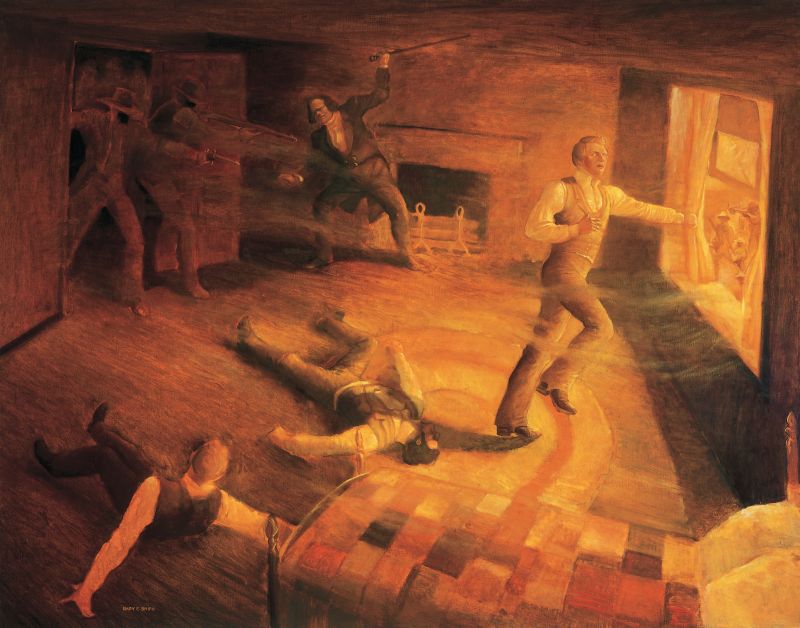
by Craig L. Foster
Recently a movie titled, “Who Killed Joseph Smith?” premiered promising “never seen before ballistic testing, research & reenactments exposing an extremely controversial theory concerning who may actually have murdered the American prophet, Joseph Smith, and his loyal brother Hyrum.” This never before seen information includes the assertion that Joseph Smith was murdered by John Taylor and Willard Richards under the orders of Brigham Young.
One person who viewed the movie described how the movie claims “Hyrum shot John once in the leg during a struggle while Joseph was out the door chasing the mob [during the attack at Carthage Jail] and firing 3 rounds. John then shot Hyrum under the chin with the exit wound through the nose. When Joseph returned to the room John shot Joseph, then Joseph shot John 3 times. Willard Richards shot Joseph in the back and pushed him out the window.”
Those with historical knowledge find such a scenario not only implausible but, quite frankly, ridiculous. While there are so many factually incorrect aspects of the “Who Killed Joseph Smith?” fantastical conspiracy theory, this short blog shall focus on just one. What weapon was Joseph Smith using to shoot John Taylor?
Willard Richards described the shooting and wound of John Taylor as follows:
Mr. Taylor rushed into the window which is some fifteen or twenty feet from the ground. When his body was nearly on a balance, a ball from the door within entered his leg, and a ball from without struck his watch, a patent lever, in his vest pocket near the left breast, and smashed it into ‘pi’ leaving the hands standing at 5 o’clock, 16 minutes, and 26 seconds— the force of which ball threw him back on the floor, and he rolled under the bed which stood by his side, where he lay motionless, the mob from the door continuing to fire upon him, cutting away a piece of flesh from his left hip as large as a man’s hand, and were hindered only by my knocking down their muzzles with a stick…
John Taylor also wrote an account of the martyrdom and his wounding:
As I reached the window and was on the point of leaping out, I was struck by a ball from the door, about midway of my thigh, which struck the bone and flattened out almost to the size of a quarter dollar, and then passed on through the fleshy part to within about half an inch of the outside. I think some prominent nerve must have been severed or injured, for as soon as the ball struck me I fell like a bird when shot, or an ox struck by a butcher, and lost entirely and instantaneously all power of action or locomotion. I fell onto the window sill and cried out I am shot. Not possessing any power to move, I felt myself falling outside of the window; but immediately I fell inside, from to me, at that time, an unknown cause; when I struck the floor my animation seemed restored, as I have sometimes seen squirrels and birds after being shot. As soon as I felt the powers of motion I crawled under a bed which was in a corner of the room not far from the window when I received my wound While on my way and under the bed, I was wounded in three other places; one ball entered a little below the left knee and never was extracted; another entered the fore part of my left arm a little above the wrist, and passing down by the joint it lodged in the fleshy part of my hand, about midway in my hand and a little above the upper joint of my little finger.
Another struck me on the fleshy part of the left hip and tore away the flesh, as large as my hand, dashing the mangled fragments of flesh and blood against the wall. My wounds were painful and the sensation produced was as though a ball had passed through and down the whole length of my leg.
John Taylor was wounded in the leg as he tried to balance on the window sill and then he fell to the floor. After falling to the floor, he was shot in the arm, hip and leg; all on the left side. The shot in the arm was superficial while the ball that entered a little below the knee was, according to Taylor, never removed.
In all likelihood, the ball that entered below the knee was not an actual ball but rather part of a ball that had broken on impact against the floor or some other hard object as a whole lead ball would have done significant damage to the knee. Furthermore, a foreign object that large would have needed to be removed while a fragment would have been small enough that it could be left in the leg as long as the leg did not become infected.
According to Joseph L. Lyon and David W. Lyon in “Physical Evidence at Carthage Jail and What It Reveals about the Assassination of Joseph and Hyrum Smith,” Joseph Smith had “a six-barreled, percussion-capignited, Allen “pepper box” revolver… Designed to be carried in a pocket, these pistols were produced in three calibers: 28, 31, and 36.” It appears the gun given to Joseph Smith by Cyrus H. Wheelock was a 31 caliber handgun.
According to witnesses, Joseph Smith fired the revolver out the door from their room at the mobbers. He is said to have fired six times, three shots hitting three people and the other three having misfired. Hyrum Smith also had a single shot pistol that was said to not have been fired during the assassinations.
The Lyons stated, “In the early and mid-nineteenth century, the federal government provided each state with U.S. military firearms for use by local militias. The U.S. Model 1816 flintlock-ignited musket … was the firearm most likely issued to the militias of Hancock County, including those of Carthage, Warsaw, and Nauvoo, though it was possible that some U.S. Model 1795 muskets were also issued. The 1816 musket was made in much larger numbers than the 1795 musket, and most 1795 muskets did not survive the War of 1812.” Therefore, it is safe to say most of the muskets used as weapons against the men in the jail were the 1816 model of musket with perhaps some 1795 muskets mixed in and, of great importance, they “were flintlock-ignited, smoothbore weapons with a bore diameter of 0.69 inches or 69 caliber.”
The average trained military and militia men were able to load and fire a musket between two and three times a minute. The more elite units are said to have been able to load and fire an average of four times a minute. It’s doubtful any of the local militia at Carthage that day would be considered elite. Ordinarily, at that time the common method of battle was infantry in line with a portion firing while another portion of the infantry were reloading so there would be a continuous fire. The Lyons give an excellent description in their article of the process of loading and firing. They also suggest that given the general inexperience of the militiamen as well as the cramped conditions of the stairs and hallway, they could have taken up to a minute to reload and fire again. Thus, they suggest the firing was probably done in waves while the men either reloaded or were passed already loaded muskets.
Now, according to the film “Who Killed Joseph Smith?”, Joseph Smith was supposed to have chased the mob, presumably down the stairs enough that they were, for the time-being, no longer a threat to the men in the upstairs room. “When Joseph returned to the room John shot Joseph, then Joseph shot John 3 times. Willard Richards shot Joseph in the back and pushed him out the window.”
This leads back to the earlier question of what weapon did Joseph Smith use to shoot John Taylor three times? Joseph had “a six-barreled, percussion-capignited, Allen “pepper box” revolver.” Available evidence show he fired the gun when the mob came up the stairs and fired into the room, wounding three men. Both John Hay and the doctor stated that Joseph Smith had a six-barrel Allen pepperbox revolver.
Even if Joseph Smith would have inexplicably chased a mob of men down the stairs and then returned to fight with John Taylor, shooting him three times, how could he have produced the damage Taylor had? He was hit in the thigh, in his forearm with the ball that then travelled down through the fleshy part of the hand, and in the leg just below the knee. And by far, what appears to have been the most serious wound, the shot to “the fleshy part of the left hip [which] tore away the flesh, as large as [a man’s] hand, dashing the mangled fragments of flesh and blood against the wall.”
Perhaps a smaller caliber ball could have hit John Taylor “midway of [his] thigh, which struck the bone, and flattened out almost to the size of a quarter of a dollar, and then passed on through the fleshy part [of his leg] to within about half an inch of the outside.” And perhaps a smaller caliber ball could have hit both the forearm and below the knee (rather than the fragment of a musket ball below the knee). But a small caliber ball could not have done the damage that was done to Taylor’s hip.
Naturally, the way a bullet enters the body will influence what the results are—damage-wise. The fact that Taylor’s flesh was torn away indicates the shot was probably not straight-on. Nevertheless, even if the shot was not straight-on it is highly unlikely a 31-caliber bullet could have caused such significant tearing and damage of the flesh. The ball was a lead ball. It was not a hollow-point bullet that would have expanded upon entry into the body. Other than ripping through the flesh because of the force of the shot, it could not have done damage based on the design of the bullet as that technique had not yet been invented.
Despite the argument that Joseph Smith shot John Taylor three times before himself being killed, the evidence points another way. Joseph Smith could not have shot Taylor with a musket and obviously a larger sized ball, such as a 69-caliber musket ball, had to have been the one that hit his hip. Thus, John Taylor’s wounds are a witness against the veracity of the theory presented in “Who Killed Joseph Smith?”
 Craig L. Foster is co-author of American Polygamy: A History of Fundamentalist Mormon Faith and co-editor of The Persistence of Polygamy Series, as well as several other books. Among a number of articles Foster has authored are, “The Butler Murder of April 1869: A Look at Extralegal Punishment in Utah,” Mormon Historic Studies 2:2 (Fall 2001); “Death to Seducers! Examples of Latter-day Saint-led Extralegal Justice in Historical Context,” Interpreter: A Journal of Latter-day Saint Faith and Scholarship 36 (2020); and “The Wrath of a Wronged Woman: Ways Nineteenth-Century Women Punished Wrongdoers,” Wild West History Association Journal 14 (December 2021).
Craig L. Foster is co-author of American Polygamy: A History of Fundamentalist Mormon Faith and co-editor of The Persistence of Polygamy Series, as well as several other books. Among a number of articles Foster has authored are, “The Butler Murder of April 1869: A Look at Extralegal Punishment in Utah,” Mormon Historic Studies 2:2 (Fall 2001); “Death to Seducers! Examples of Latter-day Saint-led Extralegal Justice in Historical Context,” Interpreter: A Journal of Latter-day Saint Faith and Scholarship 36 (2020); and “The Wrath of a Wronged Woman: Ways Nineteenth-Century Women Punished Wrongdoers,” Wild West History Association Journal 14 (December 2021).

And what about Hyrum? The bullet that killed him came through the door. Neither Taylor or Richards were outside the door when that shot came through the door. See my article in the October 2019 Journal of Mormon History–which rebuts much of what the Lyon article opines, but confirms the facts that make the current theory completely ridiculous.
Gary Smith
This movie has a pretty ridiculous thesis.
More ridiculous anti-Mormon rhetoric.
Great explanation of the claims of the movie. When I heard the theory from the movie I was very skeptical so I appreciate the facts this article brings to the table.
Thanks for your article. The premise of the movie is beyond ridiculous (not that that has ever stopped enemies of the church). However, you might want to rewrite a line of your essay: “It was not a hollow-point bullet that would have exploded upon entry into the body.” Hollow point bullets do NOT explode upon entering a body. They do *expand* to a certain degree. Hollow points are primarily designed to prevent overpenetration, though they CAN potentially do more damage to the target.
They may have had opportunity, but I question the motive.
Thanks for the correction. This has been fixed.